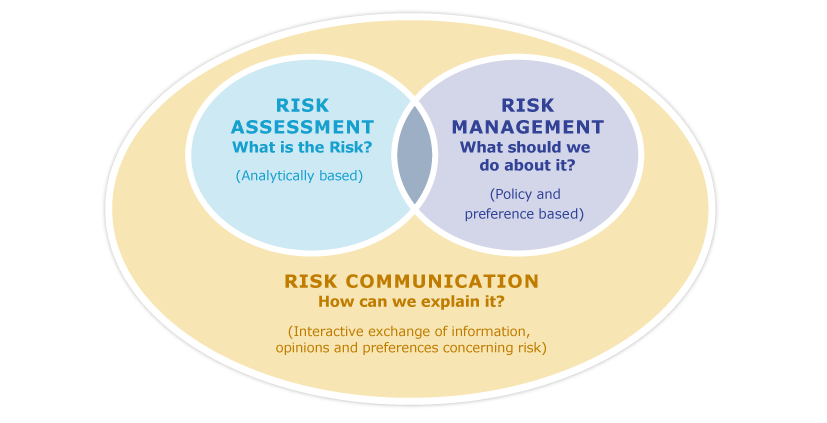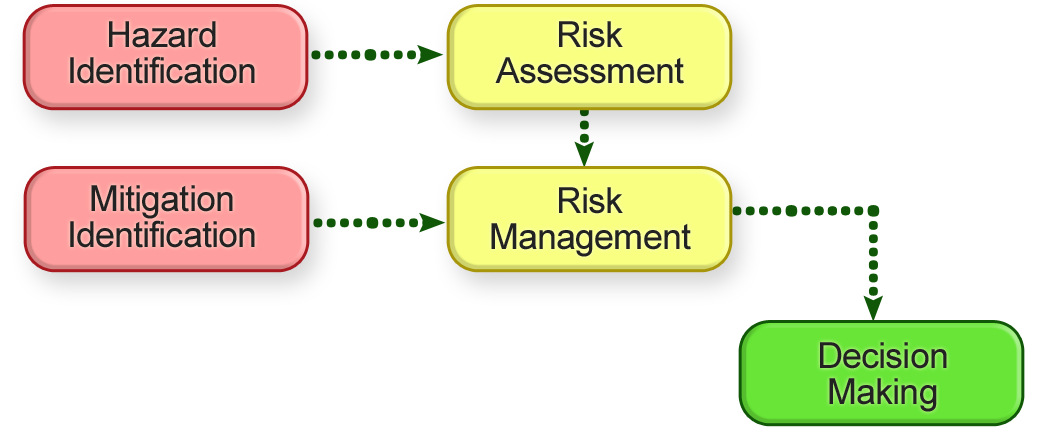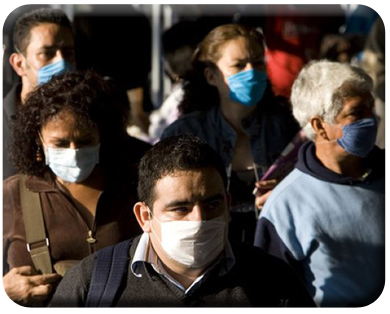Lesson 1: Introduction to Risk Analysis
Topic 1: What is Risk Analysis?
In our daily lives, each of us constantly analyzes risk. We ask questions like: Is there a risk? How bad is it? What can be done to reduce it? For the most part, this process is intuitive—in other words, we don’t stop to consider these questions explicitly. We simply evaluate and manage daily risks, gaining experience and gathering more and better information every day. In this topic, we will build on our day to day familiarity with risk and its analysis and learn how these concepts are formally defined and used in the field of risk analysis.
Objectives:
- Become familiar with the terminology used in risk analysis
- Explain what risk analysis is used for
- Explain how the perception of risk may influence our judgments
- Outline the major steps in performing/developing a risk analysis
- Explain the scientific basis of risk analysis

What is Risk?
Risk is defined as “the likelihood of an adverse event and the magnitude of the consequences.” In the field of risk analysis, this means that:
- There must be some “bad” thing, event, or outcome that we are concerned about
- There must be some probability or likelihood of that event occurring
- There must be some consequences associated with that event
Risk Perception
“Risk” is a familiar concept to most of us. We take risks every day, whether we are crossing the street, driving our cars, or selecting foods to eat. We decide which risks are acceptable and which are unacceptable to us. However, it is important to be aware that the perception of risk can play an important role in shaping our ideas about the acceptability of risk. For example, people tend to be more comfortable with risks they can control or manage (e.g., the risks associated with smoking, which people could personally control or manage by stopping smoking), even if the risks are higher, than those they cannot manage (e.g., the risks associated with air pollution—there is little we can do about this risk). When comparing an unfamiliar risk to a well-known risk (e.g., Ebola virus versus heart attack), people are more likely to perceive the unfamiliar risk as a greater threat. Risk perception will be covered in depth in the Risk Communication Module.
Use your mouse to explore examples of risk in the table below. Think about how the characteristics of the risks in the two columns would influence your personal decision on whether you deem the risk acceptable or unacceptable.
| Risks are easier to accept when they are… | Risks are harder to accept when they are… |
|---|---|
| Viewed as manageable or controllable | Not viewed as manageable or controllable |
| Well-known | Cryptic (not easily understood) |
| Easily observed | Invisible |
| Repeated consistently | Surrounded by uncertainty |
Risk Analysis
Risk analysis is defined as a systematic way of gathering, evaluating, and recording information leading to recommendations (for a position or action) in response to an identified hazard. A hazard is the entity involved in the adverse event mentioned earlier in the definition of risk. For example, in plant health, the hazard would be the pest itself (a fruit fly or a bacterial plant pathogen) and the adverse event would be pest introduction into a new country.
When performing risk analyses, we seek to identify, understand, and manage the risks so that we may reduce, avoid, or eliminate the potential for harm. The components of risk analysis are risk assessment, risk management, and risk communication. Each of these components will be addressed individually in later modules.

According to Kaplan and Garrick (1981), the three basic questions of risk analysis are:
- What can go wrong? (What is the hazard? What it the adverse event a hazard can cause?)
- What is the likelihood that it can occur?
- What are the consequences if it occurs?
As you recall from earlier modules, the SPS Agreement states that every country has the sovereign right to establish its own appropriate level of sanitary and phytosanitary protection. Furthermore, the SPS Agreement indicates that this appropriate level of protection must be based on scientific principles and evidence. It is important to keep this fundamental SPS principle in mind as you learn about risk analysis.
Likelihood
What does it mean when we say that risk is the likelihood of an adverse event? It means that for there to be risk, there must be some probability of a bad thing occurring. If the probability or likelihood is zero, then there is no risk! Uncertainty must also be present in order for there to be risk. According to the Merriam-Webster online dictionary, uncertainty is something that is doubtful or unknown. We will learn more about uncertainty later in this module. Uncertainty, although not explicit in the definition of risk, is an essential component of risk (Kaplan, 1993).

Let’s look at probability more closely. In some cases, the occurrence of an adverse event depends on a series of events, each of which has some probability or likelihood of occurring. In this case, the events are dependent. In other words, if any one of these events does not occur, then the adverse event will not come about. For example, Country A may be concerned about the risk of a pest getting introduced into Country A through imports from Country B. In order for this adverse event to occur, the following events must occur in sequence:
- The pest of concern must be present in Country B, and
- The pest needs to be associated with the goods imported into Country A (from Country B).
Dependent events, such as those illustrated above, have a multiplicative relationship; in other words, the probability of the adverse event occurring is the product of the probabilities of each event. In our example, if there is a 0.25 probability that the pest is present in Country B and there is a 0.25 probability that the pest is associated with the imported goods, then the total probability of the pest getting introduced into Country A through imports from Country B is 0.0625 (0.25 x 0.25).
Note that if either of the individual events in the example has a zero probability of occurring, then the total probability of the pest being imported into Country A is also zero (0.25 x 0 = 0).
Likelihood and probability: is there a difference? Not really. The term likelihood is commonly used when giving verbal descriptions of probabilities (e.g., low, medium, or high risk). The term probability is typically associated with numerical or mathematical descriptions. Probability may be expressed as a percent (e.g., there is a 50% chance of rain) or a decimal fraction (e.g., the probability of a “yes” vote is 0.5). A probability of 1.0 is equivalent to 100%.
Consequences
Consequences are the possible outcomes of an adverse event being realized. In general, if the consequences associated with an adverse event are serious, the risk is considered serious. Conversely, if the consequences are not serious, the risk is not serious. In risk analysis, consideration of consequences is not usually that simple. In the context of risk analysis, if there are any consequences associated with the realization of the adverse event, then there is cause for concern. So, even though a range of consequences may be possible, risk analysis will focus on the worst consequence.
Consequences are additive; in other words, the sum of each of the consequences equals the total impact of the adverse event. For example, if a species of fruit fly enters a country where it can establish, and the country has suitable and available host material, we might expect to see direct consequences, such as lower yields in hosts attacked by the fruit fly. We might also expect indirect consequences, such as loss of export markets for specific hosts. The direct (lower yields) and indirect (reduced exports) consequences can be added together to estimate the total consequences of the fruit fly introduction.

When performing risk analyses, we seek to identify, understand, and manage the risks so that we may reduce, avoid, or eliminate the potential for harm.
Move your mouse over the flowchart below to learn more about what is involved in each step of a general risk analysis process.

Hazard Identification
The first step in risk analysis is to identify the hazard and ask,“what is the risk?” This question is equivalent to asking, “what can go wrong?” To answer this question, we must collect the information (scientific or other evidence) we need to characterize the likelihood, consequences, and uncertainty associated with the hazard.
Risk Assessment
During Risk Assessment, we examine the available information for the particular situation. We conclude with a characterization of the risk based on an examination of the likelihood, consequences, and uncertainty.
Risk Management
If we determine that the risk is unacceptable, the risk analysis continues to the next phase—Risk Management. The first step is to identify possible mitigation options to reduce, avoid, or eliminate the risk. This step is known as Mitigation Identification.
Decision Making
The final stage is Decision-making. A good risk analysis will summarize the conclusions and may recommend options for management that can be considered during Decision-making.
Mitigation Identification
The identification of mitigation options (used to reduce, avoid, or eliminate the hazard).
Now that we have a general understanding of the risk analysis process, let’s consider some factors that can influence the quality of a risk analysis. Click through the following presentation to learn more.
Though familiarity with particular risks may be beneficial, it is important to note that risk analysis is a “snapshot” (or moment) in time. In other words, an analysis completed today may not yield the same results as one completed for a similar risk in the past, because situations and circumstances are always changing. After all, we are dealing with dynamic hazards–hazards that are always changing.

Is risk analysis a science, or is it science-based?
As you recall, Article 5.2 of the SPS Agreement states that available scientific evidence must be taken into account when assessing risk. Thus, it is clear that risk analysis requires science, but is it a science itself? This question is easily answered when you remember that a defining feature of science is reproducibility (obtaining the same experimental results every time).
Always remember that risk analysis uses scientific evidence but also incorporates judgments. Judgments may differ even though the risk assessment is based on the same scientific information. This lack of reproducibility is the reason why risk analysis should not be characterized as a science. Instead, most experts refer to risk analysis as a discipline.
In this topic, you learned the concepts of adverse event, hazard, likelihood, consequences, and uncertainty. These concepts are the core elements of risk that must be considered during risk analysis. The basic questions to remember about risk are: What can go wrong? What is the likelihood that it will occur? What are the consequences if it does occur? Risk analysis provides a structure for answering these questions in a systematic way. The general components of risk analysis are risk assessment, risk management, and risk communication.
To continue, select Topic 2 from the Topics menu above or click here.







